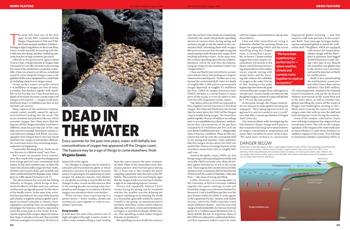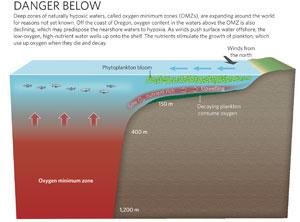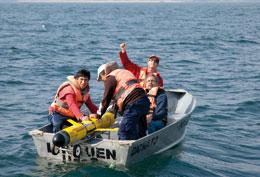 The dead fish were one of the first signs. In July 2002, scientists with the Oregon Department of Fish and Wildlife found unusual numbers of bottom-feeding sculpin lying lifeless on the ocean floor, which would normally be teeming with life. Crabs were also dying, and they washed up onto some beaches in large numbers.
The dead fish were one of the first signs. In July 2002, scientists with the Oregon Department of Fish and Wildlife found unusual numbers of bottom-feeding sculpin lying lifeless on the ocean floor, which would normally be teeming with life. Crabs were also dying, and they washed up onto some beaches in large numbers.
Officials at the government agency asked Francis Chan, a biogeochemist at Oregon State University in Corvallis, for help in discovering the cause of the disturbance as quickly as possible. Chan was about to set off on a scheduled research cruise along the Oregon coast, so he grabbed all the extra equipment he could think of, including a brand-new oxygen sensor.
Ocean surface waters normally contain 5–8 millilitres of oxygen per litre of water, a number that declines rapidly with depth. But on his first day out, Chan found that at a depth of 50 metres the inner coastal waters off Oregon were hypoxic — oxygen levels there were lower than 1.43 millilitres per litre, so low that fish can’t survive1.
Many regions of the world have hypoxic coastal waters, usually caused by agricultural fertilizers leaking into the ocean. The excess nutrients fuel plankton blooms, which consume oxygen. But Chan knew that the hypoxia off the Oregon shoreline must have a different cause, because that part of the coast does not have enough farming to explain it. And when his colleague Jack Barth, an oceanographer from Oregon State University, found similarly low oxygen levels farther offshore, the researchers knew that something unprecedented was happening.
“I remember thinking at first, ‘Lucky us, we saw this once in a lifetime event’,” says Chan.
But it wasn’t an anomaly. Every summer since then, much of the oxygen has disappeared from a large patch of inner continental-shelf waters. In the most extreme case, in 2006, the waters lost all detectable oxygen for four weeks. Starfish and mussels died, and rockfish and other mobile fish fled the hypoxic zone, which grew to 3,000 square kilometres (ref. 2).
The phenomenon has worried the fishing industry in Oregon, which brings in hundreds of millions of dollars each year and now watches each spring and summer for the return of the deadly waters. At the same time, scientists have puzzled over the cause of the hypoxia and whether it might be linked to global warming or to natural variations in climate. Oceanographers, including Chan, are scrambling to investigate the hypoxia, which is expected to reach this year’s peak in a few weeks. By tracing the origins of the oxygen-deprived waters, they hope to produce forecasts that can help fisheries managers to minimize the harm to marine life in the region.
“We have been experiencing a perfect storm — where weather, climate and currents come together to crash an ecosystem.”
The changes in Oregon may be related to a broader pattern around the globe, in which subsurface patches of permanent hypoxia seem to be growing in size and losing yet more oxygen, for unknown reasons. And whether or not global warming is responsible for the changes to date, ocean models forecast that in the coming decades increasing water temperatures and changes in circulation will drive oxygen concentrations down even further.
“What we have been experiencing is a perfect storm — where weather, climate and currents can come together to crash an ecosystem,” says Chan.
Deep trouble
In mid-June this year, Chan and his crew of eight ploughed through 3-metre swells to collect water samples along a track leading from the open ocean to the inner continental shelf. Many of the researchers wore anti-nausea patches; others turned green during the 12-hour trip as they hoisted the heavy sampling equipment onto the deck of the RV Elakha . The scientists were searching for signs that the oxygen levels were starting to decline, a sign of an impending hypoxic summer.
Storms had repeatedly delayed Chan’s cruises during the spring, and he wondered whether the weather was also delaying the oxygen’s vanishing act by keeping the winds in a favourable, generally southerly, pattern. Usually in the spring, occasional periods of northerly wind blow surface waters offshore, allowing cool waters, rich in nutrients but poor in oxygen, to upwell from deeper, offshore layers. That upwelling is what makes Oregon’s fisheries so productive.
But upwelling can turn deadly for creatures near the sea floor if the winds are unrelenting. Normally, the winds that promote upwelling slacken at various times during spring and summer, enough to mix the waters on the continental shelf, refreshing them with oxygen. But some recent years have brought strong and steady spring winds that prevent oxygen from reaching subsurface waters. At the same time, the constant upwelling spurs blooms of phytoplankton, which die and then decompose, using up oxygen in the nearshore waters.
 Chan and Barth have identified a second, more distant, factor that predisposes Oregon’s waters to become hypoxic. Farther out to sea, beyond the continental shelf, water at a depth of roughly 600–1,200 metres is permanently oxygen deprived, at roughly 0.5 millilitres per litre. Called an oxygen minimum zone (OMZ), the layer is a normal feature in many parts of the ocean; it is too far down to mix with the well oxygenated surface waters.
Chan and Barth have identified a second, more distant, factor that predisposes Oregon’s waters to become hypoxic. Farther out to sea, beyond the continental shelf, water at a depth of roughly 600–1,200 metres is permanently oxygen deprived, at roughly 0.5 millilitres per litre. Called an oxygen minimum zone (OMZ), the layer is a normal feature in many parts of the ocean; it is too far down to mix with the well oxygenated surface waters.
The waters above an OMZ are expected to have slightly lowered amounts of dissolved oxygen. But Chan and Barth have discovered that the water above the OMZ off the Oregon coast is steadily losing oxygen. The researchers pulled together 30 years of offshore recordings and, in an unpublished preliminary analysis, found that concentrations of the gas have dropped by 0.5 millilitres per litre and are now about 2 millilitres per litre — dangerously close to hypoxic conditions. These are the very waters that well up onto the continental shelf in the spring and summer. Chan estimates that this oxygen decline above the OMZ has pushed the chances of seeing hypoxia in the nearshore waters from 10% to roughly 60% each year.
Around the globe, many OMZs are also losing oxygen and expanding horizontally and vertically. OMZs currently cover about 30 million square kilometres, or 8% of the ocean area. These regions have mostly attracted little attention from researchers, but the best known OMZs sit off the coasts of Namibia, Chile and Peru — also areas of strong upwelling.
Lothar Stramma, an oceanographer at the University of Kiel in Germany, cobbled together the sparse existing records and found that oxygen concentrations declined by between 0.1 and 0.4 millilitres per litre over the past 50 years within the OMZs in most regions of the equatorial Pacific, Atlantic and Indian Oceans, where the OMZs naturally reach much shallower depths3. And the area with oxygen levels intolerable for fish survival had grown by 4.5 million square kilometres (ref. 4), about double the size of Argentina. Many of the OMZs are adjacent to continental shelves, and their expansion makes it easier for water with low oxygen concentrations to lap up onto those shelves.
Chan and other researchers are trying to determine whether the warming climate is to blame for expanding OMZs and the recent upwelling along the Oregon coast. A connection is possible, in theory. Climate models suggest that ocean oxygen concentrations will decline in the future, mainly because increasing temperatures of the surface waters impede mixing with deeper layers, and the warming also reduces the solubility of oxygen in the water. On top of that, heating of the polar regions may slow down the giant currents that carry oxygen from cold regions to warmer ones. Various model runs forecast that the global oxygen content of oceans will decline by 1–7% over the next century5.
At this point, though, the Oregon researchers are reticent to make global warming the scapegoat. “We’re being rigorous in how we approach it, and are careful to not cry wolf,” says Alan Mix, a marine geochemist at Oregon State University.
The main problem with investigating the link between climate change and hypoxia is that researchers lack long-term measurements of oxygen concentration, temperature and many other variables for most of the ocean. “We need more evidence to conclusively fingerprint global warming — and that requires a full-time presence in the ocean,” says Barth. Four years ago, he began deploying two automated gliders to patrol the continental shelf. The gliders, which are equipped with sensors for temperature, salinity, oxygen and the chlorophyll in plankton, have logged 36,400 kilometres to date during 1,664 days at sea. Shaped like torpedoes, the gliders pop to the surface every six hours and send the data back to Barth by satellite phone.
Barth is also spearheading the northwestern coastal portion of the Ocean Observatories Initiative. This $385-million, US-wide programme, funded by the National Science Foundation, will pay for an array of offshore instruments on the ocean floor and in the water above, as well as a further four gliders patrolling the waters off the coasts of Oregon and Washington, starting in 2012. Barth wants to locate the source of the low-oxygen water that wells up onto the shelf and feeds the hypoxic events during the summer.
 Some of the samples collected by Chan’s crew will help to pinpoint the origin of those unwelcome waters. Mix will use the isotopic signature of the oxygen in the water molecules to track whether it came from northern or southern regions of the ocean. This will help to determine whether expanding OMZs in distant parts of the Pacific have contributed to the hypoxia events on the continental shelf of Oregon. If so, the fish deaths there may serve as a warning to other coastal zones in the ocean, which may soon start to see similar hypoxia.
Some of the samples collected by Chan’s crew will help to pinpoint the origin of those unwelcome waters. Mix will use the isotopic signature of the oxygen in the water molecules to track whether it came from northern or southern regions of the ocean. This will help to determine whether expanding OMZs in distant parts of the Pacific have contributed to the hypoxia events on the continental shelf of Oregon. If so, the fish deaths there may serve as a warning to other coastal zones in the ocean, which may soon start to see similar hypoxia.
Fishing for answers
Some researchers in southern California are already on the alert. They have yet to see any effects on fisheries, but deeper waters off the continental margin have experienced a 20–30% decline in oxygen, according to Lisa Levin, a marine biologist at the Scripps Institution of Oceanography in La Jolla, California.
“Right now, it’s still out of sight, out of mind,” says Levin of the low-oxygen water. But the hypoxic conditions are creeping up the water column, rising by as much as 90 metres between 1984 and 2006 off the coast of Santa Barbara, California6.
“My view, which is only an educated guess, as we don’t have all the information, is that the expansion of OMZs that we’ve seen recently is driven by natural cycles,” says Francisco Chavez, a biological oceanographer at the Monterey Bay Aquarium Research Institute in Moss Landing, California. But if ocean circulation slows over the coming decades, as it is expected to do, many OMZs will expand, including the world’s largest, which spans the southwestern coast of North America and the northwestern coast of South America. The Oregon State University team’s working hypothesis is that the growing OMZs will come within reach of many coastal regions, raising the risk that upwelling currents will carry oxygen-starved waters to areas that have thus far remained free from hypoxia.
Chan says that his most immediate concern is how to advise fisheries managers, who are already facing waters that are growing warmer and more acidic because of climate change and increasing levels of dissolved carbon dioxide. “We have no idea whether marine organisms will be able to adapt to such fast changes,” he says. “This is evolution in real time.”
Bottom dwellers, such as crabs and starfish, are most vulnerable to the hypoxia and die first. Humboldt squid, which are tolerant of low-oxygen conditions, move in to feast on the remains. These 1.75-metre cephalopods have become a mascot of low-oxygen studies; the arrival of the squid and changes in the population of microbes are considered signs of a system in trouble (see ‘Natural born sensors’).
Unlike bottom dwellers, fish can swim away from the hypoxic waters, and fishermen have learned to take advantage of that behaviour. “As OMZs expand and move closer to shore, they push the intolerant species upwards and narrow the amount of the water column they have to live in,” says Levin. That makes them easier to catch, so even stocks of fish that have escaped the hypoxia are vulnerable to its impacts.
“We’re going to have to manage fisheries differently,” says Frank Whitney, an oceanographer with Fisheries and Oceans Canada, based in Victoria, British Columbia. In the past, he says, there was enough oxygen in the ocean, so fish could find refuges when upwelling caused local hypoxia. But that may be changing. If oxygen levels continue to decline, he says, managers may have to think about setting aside marine reserves — areas closed to fishing — in both deep and shallow waters to give fish ample refuges during hypoxic events.
Off the coast of Oregon, the situation seemed promising this spring, because the storms kept the coastal waters well oxygenated. Chan and other researchers there had hoped that the weather might break the recent cycle of hypoxia. But when he went out on the RV Elakha in June, Chan found that oxygen values had started to drop just as they have every year since 2002. He returned to sea late last month and saw a that there has been a steady decline in oxygen in the nearshore waters. Summertime hypoxia, it seems, has become the norm in this part of the world.
Virginia Gewin is a freelance writer based in Portland, Oregon.
Source: http://www.nature.com/
Dear User/Visitor! Please, answer on our questions: tick off one of the positions – your answer will make us able to improve our site and make it more interesting and useful!

